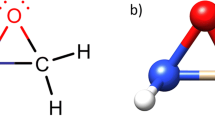Abstract
Effects of core electrons on total energy, correlation energy, and binding energy of graphene, graphite, and diamond have been investigated along with density functional theory (DFT) calculations at the PBE level of theory using all electron and frozen-core calculations. For these calculations, correlation-consistent basis sets cc-pVXZ and cc-pCVXZ have been used where X is the cardinal number that represents the maximum angular momentum number in the basis set. By taking the difference between all electron and frozen-core calculations, core-electron binding energy contribution for each basis set has been obtained. It has been shown that to reduce the effects of core electrons, large basis sets should be used.






Similar content being viewed by others
References
Geim, A.K., Novoselov, K.S.: The rise of graphene. Nat. Commun. 6, 183–191 (2007)
Stoller, M.D., Park, S.J., Zhu, Y.W., Ann, J.H., Ruoff, R.S.: Graphene-based ultracapacitors. Nanolett 8, 3498–3502 (2008)
Wang, Y., Shi, Z.Q., Huang, Y., Ma, Y.F., Wang, C.Y., Chen, M.M., Chen, Y.S.: Supercapacitor devices based on graphene materials. J. Phys. Chem. C 113, 13103–13107 (2009)
Qin, M.M., Feng, Y.Y., Ji, T.X., Feng, W.: Enhancement of cross-plane thermal conductivity and mechanical strength via vertical aligned carbon nanotube@graphite architecture. Carbon 104, 157–168 (2016)
Yang, K., Feng, L.Z., Shi, X.Z., Liu, Z.: Nano-graphene in biomedicine: theranostic applications. Chem. Soc. Rev. 42, 530–547 (2013)
Niu, Y.B, Xu, M.W., Guo, C.X., Li, C.M.: Pyro-synthesis of a nanostructured NaTi2(PO4)(3)/C with a novel lower voltage plateau for rechargeable sodium-ion batteries. J. Colloid Interface Sci. 474, 88–92 (2016)
Wan, F., Lu, H.Y., Zhang, X.H., Liu, D.H., Zhang, J.P., He, X.Y., Wu, X.L.: The in-situ-prepared micro/nanocomposite composed of Sb and reduced graphene oxide as superior anode for sodium-ion batteries. J. Alloy. Compd. 672, 72–78 (2016)
Liang, M.H., Zhi, L.J.: Graphene-based electrode materials for rechargeable lithium batteries. J. Mater. Chem. 19, 5871–5878 (2009)
Kim, M.II, Kim, M.S., Woo, M.A., Ye, Y., Kang, K.S., Lee, J, Park, H.G.: Highly efficient colorimetric detection of target cancer cells utilizing superior catalytic activity of graphene oxide-magnetic-platinum nanohybrids. Nanoscale 6, 1529–1536 (2014)
Lin, Z.Z.: Graphdiyne as a promising substrate for stabilizing Pt nanoparticle catalyst. Carbon 86, 301–309 (2015)
Jahani, D., Abaspour, L., Soltani-Vala, A., Barvestani, J.: A leap over Dirac Cones in one-dimensional graphene based photonic crystals. Physcia B 491, 93–97 (2016)
Mousavi, H., Bagheri, M.: Electronic properties of impurity-infected few-layer graphene nanoribbons. Physica B 458, 107–113 (2015)
Heerema, S.J., Dekker, C.: Graphene nanodevices for DNA sequencing. Nat. Nanotechnol. 11, 127–136 (2016)
Madani, A., Entezar, S.R.: Optical properties of one-dimensional photonic crystals containing graphene sheets. Physica B 431, 1–5 (2013)
Srinivas, G., Zhu, Y.W., Piner, R., Skipper, N., Ellerby, M., Ruoff, R.: Synthesis of graphene-like nanosheets and their hydrogen adsorption capacity. Carbon 48, 630–635 (2010)
Ferri, A.C.: Raman spectroscopy of graphene and graphite: disorder, electron-phonon coupling, doping and nonadiabatic effects. Solid State Commun. 143, 47–57 (2007)
Balog, R., Jorgensen, B., Nilsson, L., Andersen, M., Rienks, E., Bianchi, M., Fanetti, M., Laegsgaard, E., Baraldi, A., Lizzit, S., Sljiivancanin, Z., Besenbacher, F., Hammer, B., Pedersen, T. G., Hofmann, P., Hornekaer, L.: Bandgap opening in graphene induced by patterned hydrogen adsorption. Nat. Mater. 9, 315–319 (2010)
Mogulkoc, A.: Effects of electron-acoustic phonon interaction in the presence of spin-orbit couplings in graphene. Physica B 473, 20–25 (2015)
Okamoto, Y.: Density-functional calculations of icosahedral M13 (M=Pt and Au) clusters on graphene sheets and flakes. Chem. Phys. Lett. 420, 382–386 (2006)
Zhu, T.Y., de Silva, P., van Aggelen, H., Van Voorhis, T.: Many-electron expansion: a density functional hierarchy for strongly correlated systems. Phys. Rev. B 93, 21108 (2016)
Tao, J.M., Perdew, J.P., Staroverov, V.N., Scuseria, G.E.: Climbing the density functional ladder: nonempirical meta-generalized gradient approximation designed for molecules and solids. Phys. Rev. Lett. 91, 146401 (2003)
May, A.J., Valeev, E., Polly, R., Manby, F.R.: Analysis of the errors in explicitly correlated electronic structure theory. Phys. Chem. Chem. Phys. 7, 2710–2713 (2005)
Dunning, T.H.: Gaussian-basis sets for use in correlated molecular calculations. 1. The atoms boron through neon and hydrogen. J. Chem. Phys. 90, 1007–1023 (1989)
Dunning, T.H.: A road map for the calculation of molecular binding energies. J. Phys. Chem. A 104, 9062–9080 (2000)
Dunning, T.H., Peterson, K.A.: Approximating the basis set dependence of coupled cluster calculations: evaluation of perturbation theory approximations for stable molecules. J. Chem. Phys. 113, 7799–7808 (2000)
Bagus, P.S., Sousa, C., Illas, F.: Consequences of electron correlation XPS binding energies: representative case for C(1s) and O(1s) XPS of CO. J. Chem. Phys. 145, 144303 (2016)
Foglia, N.O., Morzan, U.N., Estrin, D.A., Scherlis, D.A., Lebrero, M.C.G.: Role of core electrons in quantum dynamics using TDDFT. J. Chem. Theory. Comput. 13, 77–85 (2017)
Tolbatov, I., Chipman, D.M.: Comparative study of Gaussian basis sets for calculation of core electron binding energies in first row hydrides and glycine. Theor. Chem. Acc. 133, 1560 (2014)
Takahata, Y.: Substituent effects in chain and ring pi-systems studied by core-electron binding energies calculated by density functional theory. Comput. Theor. Chem. 978, 77–83 (2011)
Takahata, Y.: Substituent effect in 1-X-decanes and 3-X-gonanes based on core-electron binding energies calculated with density-functional theory. Comput. Theor. Chem. 1024, 9–14 (2013)
Neese, F.: ORCA program system. Comput. Mol. Sci. 2, 73–78 (2012)
Perdew, J.P., Burke, K., Ernzerhof, M.: Generalized gradient approximation made simple. Phys. Rev. Lett. 77, 3865 (1996)
Lide, D.R. (ed.): In: Chemical Rubber Company Handbook of Chemistry and Physics, 79th edn. CRC Press, Boca Raton (1998)
Author information
Authors and Affiliations
Corresponding author
Rights and permissions
About this article
Cite this article
Akbudak, S., Ellialtıoğlu, M.R. Effect of Core Electrons in Defining the Total Energy, Correlation Energy, and Binding Energy of Graphene, Graphite, and Diamond: a First-Principles Study. J Supercond Nov Magn 31, 3097–3104 (2018). https://doi.org/10.1007/s10948-018-4577-z
Received:
Accepted:
Published:
Issue Date:
DOI: https://doi.org/10.1007/s10948-018-4577-z




